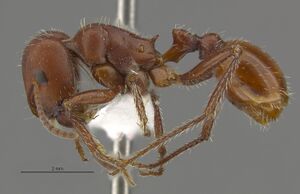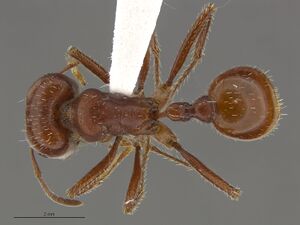Pogonomyrmex wheeleri
| Pogonomyrmex wheeleri | |
|---|---|

| |
| Scientific classification | |
| Kingdom: | Animalia |
| Phylum: | Arthropoda |
| Class: | Insecta |
| Order: | Hymenoptera |
| Family: | Formicidae |
| Subfamily: | Myrmicinae |
| Tribe: | Pogonomyrmecini |
| Genus: | Pogonomyrmex |
| Species group: | barbatus |
| Species: | P. wheeleri |
| Binomial name | |
| Pogonomyrmex wheeleri Olsen, 1934 | |
The workers are extremely pugnacious; they swarm toward the intruder at a rapid gait. Such a formidable array made collections from the nests a difficult and painful task, for the ants sting readily and, I might add, very effectively. (Cole 1968)
Identification
Pogonomyrmex wheeleri seems to be most closely related to Pogonomyrmex barbatus from which it differs chiefly in the more massive pronotum and its notably steeper anterior declivity, the finer, more dense cephalic and thoracic rugae, and the larger average size. The fine, dense, cephalic rugosity is much like that of Pogonomyrmex desertorum, but wheeleri lacks the smooth posterior corners of the head, the conformation of the scape base and thorax, and the small body size which characterize desertorum. The wheeleri worker is, on the average, the largest of all known North American species of Pogonomynnex.
Keys including this Species
Distribution
Known only from Sinaloa and northern Nayarit, Mexico.
Latitudinal Distribution Pattern
Latitudinal Range: 28.471356° to 17.5°.
| North Temperate |
North Subtropical |
Tropical | South Subtropical |
South Temperate |
- Source: AntMaps
Distribution based on Regional Taxon Lists
Neotropical Region: Mexico (type locality).
Distribution based on AntMaps
Distribution based on AntWeb specimens
Check data from AntWeb
Countries Occupied
| Number of countries occupied by this species based on AntWiki Regional Taxon Lists. In general, fewer countries occupied indicates a narrower range, while more countries indicates a more widespread species. |

|
Estimated Abundance
| Relative abundance based on number of AntMaps records per species (this species within the purple bar). Fewer records (to the left) indicates a less abundant/encountered species while more records (to the right) indicates more abundant/encountered species. |

|
Biology
The nests are mostly in sandy-gravelly or clayey, soils at sea level to elevations of less than 500 feet. The nest superstructure is generally a low (1-4 inches) domed mound of sand and gravel or of clay varying from 2 to 3 feet in diameter, but sometimes it consists of only a flat disc of sand and gravel or of clay and gravel. Each nest bears a single, somewhat central entrance and a peripherally cleared area. Distinct foraging trails radiate from the nest through the surrounding vegetation. Most colonies are very populous. Numerous nests were observed in the vicinity of Mazatlan and along the highway south of that city to the environs of Escuinapa, the type locality of wheeleri. My easternmost record comes from a station twenty-three miles east of Mazatlan. (Cole 1968)
Castes
   
| |
| . | Owned by Museum of Comparative Zoology. |
Nomenclature
The following information is derived from Barry Bolton's Online Catalogue of the Ants of the World.
- wheeleri. Pogonomyrmex wheeleri Olsen, 1934: 511, pl. 6, fig. 1 (w.) MEXICO. Snelling, R.R. 1982a: 106 (q.m.). See also: Cole, 1968: 81.
Unless otherwise noted the text for the remainder of this section is reported from the publication that includes the original description.
Description
Worker
Cole (1968) - HL 2.32-2.47 mm, HW 2.72-2.89 mm, CI 115.2-117.0, SL 1.56-1.71 mm, SI 57.3-58.9, EL 0.49-0.53 mm, EW 0.27-0.34 mm, OI 19.9-21.0, WL 2.62-2.89 mm, PNL 0.61-0.66 mm, PNW 0.57-0.66 mm, PPL 0.53-0.61 mm, PPW 0.87-0.95 mm.
Mandible as shown in Pl. III, Fig. 16; teeth rather short, robust; apical and subapical teeth subequal in length, often fused basally; second and third basals subequal in length, a little shorter than first basal; penultimate basal small, shorter than all other teeth; ultimate basal broad, as long as subapical and apical teeth; apical tooth not much longer than first, second, and third basals; penultimate basal tooth sometimes absent, but the space it would occupy remains.
Base of antennal scape as illustrated in Pl. IV, Fig. 13; shaft moderately strongly curved in basal half, strongly constricted and somewhat flattened along the bend; basal enlargement well developed; superior lobe very strong, triangular, the apex acute; superior declivity long, rather steep, meeting the shaft evenly at a very weak, broadly rounded angle; basal flange weak, narrow, the margin thin and extending to apex of superior lobe; lip moderately large, prominent, bipartite; inferior declivity long, rather weak, interrupted by a small point, meeting the shaft smoothly at a weak, very broadly rounded angle; longitudinal peripheral carina distinct but narrow, the basal impression it borders extensive and rather deep.
Head very finely, densely rugulose, the rugulae closely spaced, parallel, producing a silky appearance; interrugal spaces shining, densely and finely punctate; posterior corners of head not smooth and shining.
Contour of thorax, petiole, and postpetiole, in lateral view, as illustrated in Pl. V, Fig. 5; anterior declivity of pronotum steep; apex of pronolum generally bearing a small, distinct, blunt, median projection in front of which is a smooth, shining area; epinotum bearing a pair of robust spines, short to long, sometimes clavate, generally pointed, base notably broader than apex. Conformation of petiolar and postpetiolar nodes, in dorsal view, as shown in Pl. VII, Fig. 20. Thoracic rugae fine, dense, transverse or longitudinal on mesonotum, mostly transverse elsewhere, very delicate on propleura; interrugal spaces finely and, except on propleura, rather sparsely punctate and shining, those on propleura densely and prominently punctate and subopaque; infraspinal facet smooth and shining. Ventral, petiolar, peduncular lobe and ventral, postpetiolar process well developed. Dorsum of petiolar and postpetiolar nodes finely shagreenecl, rather shining, frequently bearing a few weak, transverse rugules or striae on posterior portion. Gaster finely and faintly shagreened, strongly shining.
Body and appendages a concolorous, light to medium ferrugineous red; pronatal projection deep brown.
References
- Cole, A. C., Jr. 1968. Pogonomyrmex harvester ants. A study of the genus in North America. Knoxville, Tenn.: University of Tennessee Press, x + 222 pp. (page 81, see also)
- Olsen, O. W. 1934. Notes on the North American harvesting ants of the genus Pogonomyrmex Mayr. Bulletin of the Museum of Comparative Zoology 77: 493-514 (page 511, pl. 6, fig. 1 worker described)
- Snelling, R. R. 1982a [1981]. The taxonomy and distribution of some North American Pogonomyrmex and descriptions of two new species (Hymenoptera: Formicidae). Bull. South. Calif. Acad. Sci. 80: 97-112 (page 106, queen, male described)
References based on Global Ant Biodiversity Informatics
- Brandao, C.R.F. 1991. Adendos ao catalogo abreviado das formigas da regiao neotropical (Hymenoptera: Formicidae). Rev. Bras. Entomol. 35: 319-412.
- Cole, A.C. 1968. Pogonomyrmex harvester ants: A study of the genus in North America. University of Tennesee Press. Knoxville
- Dattilo W. et al. 2019. MEXICO ANTS: incidence and abundance along the Nearctic-Neotropical interface. Ecology https://doi.org/10.1002/ecy.2944
- Fernandes, P.R. XXXX. Los hormigas del suelo en Mexico: Diversidad, distribucion e importancia (Hymenoptera: Formicidae).
- Mackay, W.P., E.E. Mackay, J.F. Perez Dominguez, L.I. Valdez Sanchez and P.V. Orozco. 1985. Las hormigas del estado de Chihuahua Mexico: El genero Pogonomyrmex (Hymenoptera: Formicidae) . Sociobiology 11(1):39-54
- Snelling, R.R. 1981. The taxonomy and distribution of some North American Pogonomyrmex and descriptions of two new species (Hymenoptera: Formicidae). Bulletin of the Southern California Academy of Science 80(3):97-112.
- Vásquez-Bolaños M. 2011. Lista de especies de hormigas (Hymenoptera: Formicidae) para México. Dugesiana 18: 95-133

